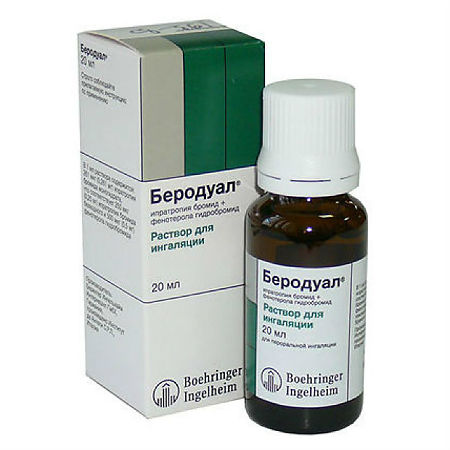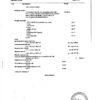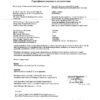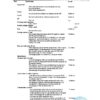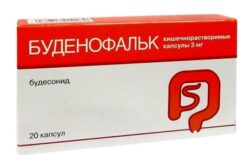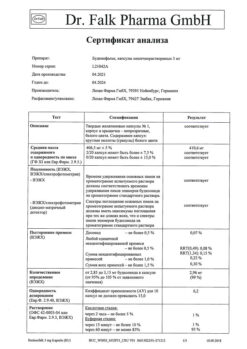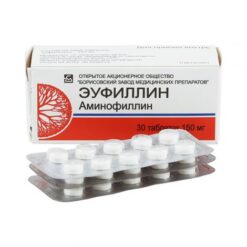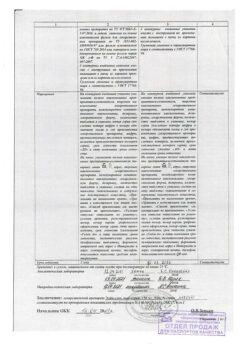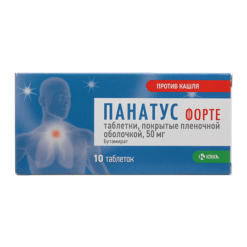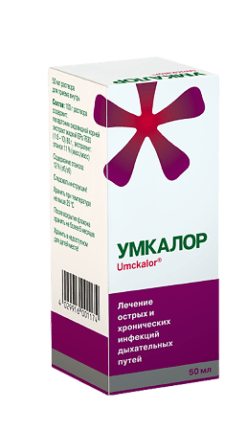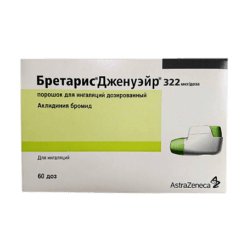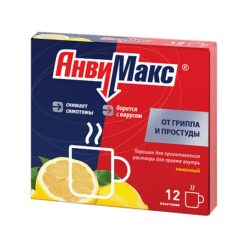No products in the cart.
Berodual, 0.25mg+0.5mg/ml 20 ml
€8.00 €7.18
Description
Combined bronchodilator drug. It contains two components with bronchodilator activity: ipratropium bromide – m-cholinoblocker and fenoterol hydrobromide – beta2-adrenomimetic.
The bronchodilation by inhaled administration of ipratropium bromide is mainly due to local rather than systemic anticholinergic action.
Ipratropium bromide is a quaternary ammonium derivative with anticholinergic (parasympatholytic) properties. The drug inhibits vagus nerve reflexes by counteracting the effects of acetylcholine, a mediator released from the vagus nerve endings. Anticholinergic agents prevent an increase in intracellular calcium concentration, which occurs due to the interaction of acetylcholine with the muscarinic receptor located on bronchial smooth muscle. Calcium release is mediated by a system of secondary mediators, including ITP (inositol triphosphate) and DAG (diacylglycerol).
In patients with bronchospasm associated with COPD (chronic bronchitis and pulmonary emphysema), a significant improvement in pulmonary function (increase in forced expiratory volume in 1 second (FEF1) and peak expiratory rate by 15% or more) was noted within 15 minutes, the maximum effect was achieved in 1-2 h and lasted in most patients up to 6 h after administration.
Ipratropium bromide has no adverse effect on airway mucus secretion, mucociliary clearance, and gas exchange.
Phenoterol hydrobromide selectively stimulates β2-adrenoreceptors at therapeutic dose. Stimulation of β1-adrenoreceptors occurs when using high doses (e.g., when prescribed for tocolytic action).
Fenoterol relaxes the smooth muscles of the bronchi and vessels and counteracts the development of bronchospastic reactions due to the effects of histamine, methacholine, cold air and allergens (immediate-type hypersensitivity reactions). Immediately after administration, fenoterol blocks the release of inflammatory mediators and bronchoobstruction from mast cells. In addition, an increase in mucociliary clearance has been observed when using fenoterol at a dose of 600 mcg.
The beta-adrenergic effects of the drug on cardiac activity, such as increase in HR and heart rate, are due to the vascular action of fenoterol, stimulation of β2-adrenoreceptors of the heart, and when used in doses higher than therapeutic, stimulation of β1-adrenoreceptors.
As with other beta-adrenergic drugs, prolongation of the QTc interval was noted with high doses. When fenoterol was used with metered-dose aerosol inhalers (MDIs), this effect was inconsistent and was noted when doses higher than recommended were used. However, after using fenoterol with nebulizers (standard-dose inhalation solution in vials), the systemic effect may be higher than when using the drug with DAIs at the recommended doses. The clinical significance of these observations has not been established.
The most commonly observed effect of β-adrenoreceptor agonists is tremor. In contrast to the effects on bronchial smooth muscles, tolerance may develop to the systemic effects of β-adrenoreceptor agonists The clinical significance of this manifestation is unclear.
When using ipratropium bromide and fenoterol together, the bronchodilator effect is achieved by affecting different pharmacological targets. The mentioned substances complement each other, and as a result the antispasmodic effect on the bronchial muscles increases and a wider therapeutic effect is achieved in bronchopulmonary diseases accompanied with airway constriction.
The complementary action is such that a lower dose of the beta-adrenergic component is required to achieve the desired effect, allowing an individualized effective dose with virtually no side effects.
Indications
Indications
Prevention and symptomatic treatment of chronic obstructive respiratory diseases with reversible bronchospasm, such as bronchial asthma and, especially, chronic obstructive pulmonary disease (chronic obstructive bronchitis and emphysema).
Pharmacological effect
Pharmacological effect
Combined bronchodilator drug. Contains two components with bronchodilator activity: ipratropium bromide – an m-anticholinergic blocker and fenoterol hydrobromide – a beta2-adrenergic agonist.
Bronchodilation with inhaled ipratropium bromide is due primarily to local rather than systemic anticholinergic effects.
Ipratropium bromide is a quaternary ammonium derivative with anticholinergic (parasympatholytic) properties. The drug inhibits reflexes caused by the vagus nerve, counteracting the effects of acetylcholine, a neurotransmitter released from the endings of the vagus nerve. Anticholinergics prevent the increase in intracellular calcium concentration, which occurs due to the interaction of acetylcholine with the muscarinic receptor located on the smooth muscles of the bronchi. The release of calcium is mediated by a system of secondary mediators, which include ITP (inositol triphosphate) and DAG (diacylglycerol).
In patients with bronchospasm associated with COPD (chronic bronchitis and emphysema), a significant improvement in lung function (an increase in forced expiratory volume in 1 second (FEV1) and peak expiratory flow by 15% or more) was noted within 15 minutes, the maximum effect was achieved after 1-2 hours and lasted in most patients up to 6 hours after administration.
Ipratropium bromide does not have a negative effect on mucus secretion in the respiratory tract, mucociliary clearance and gas exchange.
Fenoterol hydrobromide selectively stimulates β2-adrenergic receptors at a therapeutic dose. Stimulation of β1-adrenergic receptors occurs when high doses are used (for example, when prescribed for tocolytic action).
Fenoterol relaxes the smooth muscles of the bronchi and blood vessels and counteracts the development of bronchospastic reactions caused by the influence of histamine, methacholine, cold air and allergens (immediate hypersensitivity reactions). Immediately after administration, fenoterol blocks the release of mediators of inflammation and bronchial obstruction from mast cells. In addition, when using fenoterol at a dose of 600 mcg, an increase in mucociliary clearance was noted.
The beta-adrenergic effect of the drug on cardiac activity, such as an increase in heart rate and strength of heart contractions, is due to the vascular effect of fenoterol, stimulation of β2-adrenergic receptors of the heart, and when used in doses exceeding therapeutic doses, stimulation of β1-adrenergic receptors.
As with the use of other beta-adrenergic drugs, prolongation of the QTc interval was observed when using high doses. When fenoterol was used via metered-dose aerosol inhalers (MDIs), the effect was inconsistent and occurred at doses higher than recommended. However, following administration of fenoterol via nebulizers (inhalation solution in unit dose vials), systemic exposure may be higher than when using the drug via a MDI at recommended doses. The clinical significance of these observations has not been established.
The most commonly observed effect of β-adrenergic agonists is tremor. In contrast to the effects on bronchial smooth muscle, tolerance may develop to the systemic effects of β-adrenergic agonists. The clinical significance of this manifestation is not clear.
When ipratropium bromide and fenoterol are used together, the bronchodilator effect is achieved by acting on various pharmacological targets. These substances complement each other, as a result, the antispasmodic effect on the bronchial muscles is enhanced and a greater breadth of therapeutic action is provided for bronchopulmonary diseases accompanied by constriction of the airways.
The complementary effect is such that to achieve the desired effect, a lower dose of the beta-adrenergic component is required, which allows you to individually select an effective dose with virtually no side effects.
Special instructions
Special instructions
The patient should be informed that if shortness of breath (difficulty breathing) suddenly increases rapidly, consult a doctor immediately.
It should be taken into account that in patients with bronchial asthma Berodual® should be used only as needed. In patients with mild chronic obstructive pulmonary disease, symptomatic treatment may be preferable to regular use.
In patients with bronchial asthma, one should remember the need to carry out or intensify anti-inflammatory therapy to control the inflammatory process of the respiratory tract and the course of the disease.
Regular use of increasing doses of drugs containing beta2-adrenergic agonists, such as Berodual®, to relieve bronchial obstruction can cause uncontrolled worsening of the disease. In case of increased bronchial obstruction, a simple increase in the dose of beta2-adrenergic agonists (including Berodual) more than recommended for a long time is not only not justified, but also dangerous. To prevent life-threatening worsening of the disease, consideration should be given to revising the patient’s treatment plan and adequate anti-inflammatory therapy with inhaled corticosteroids.
In patients with a history of cystic fibrosis, gastrointestinal motility disorders are possible.
Other sympathomimetic bronchodilators should be prescribed concomitantly with Berodual only under medical supervision.
Patients should be instructed on the correct use of Berodual inhalation solution. To prevent the solution from getting into the eyes, it is recommended that the solution used with a nebulizer be inhaled through the mouthpiece. If there is no mouthpiece, a mask that fits tightly to the face should be used. Patients predisposed to developing glaucoma should take special care to protect their eyes.
Berodual should be used with caution in patients predisposed to developing acute-angle glaucoma or in patients with concomitant urinary tract obstruction (for example, prostatic hyperplasia or bladder neck obstruction).
In athletes, the use of Berodual due to the presence of fenoterol in its composition can lead to positive results of doping tests.
The drug contains a preservative – benzalkonium chloride and a stabilizer – disodium edetate dihydrate. During inhalation, these components may cause bronchospasm in sensitive patients with airway hyperresponsiveness.
Impact on the ability to drive vehicles and operate machinery
No studies have been conducted on the effects of the drug on the ability to drive vehicles and use machinery. However, patients should be warned that during treatment with Berodual they may experience undesirable sensations such as dizziness, tremor, disturbances in ocular accommodation, mydriasis and blurred vision. Therefore, caution should be recommended when driving vehicles or using machinery. If patients experience the above unwanted sensations, they should refrain from potentially dangerous activities such as driving a car or operating machinery.
Active ingredient
Active ingredient
Ipratropium bromide, Fenoterol
Composition
Composition
1 ml of solution for inhalation contains:
Contraindications
Contraindications
Hypertrophic obstructive cardiomyopathy, tachyarrhythmia, I and III trimesters of pregnancy. Hypersensitivity to fenoterol or atropine-like drugs or other components of this drug.
With caution: angle-closure glaucoma, arterial hypertension, diabetes mellitus, recent myocardial infarction (within the last 3 months), heart and vascular diseases, such as chronic heart failure, coronary heart disease, heart disease, aortic stenosis, severe damage to the cerebral and peripheral arteries.
Hyperthyroidism, pheochromocytoma, prostatic hyperplasia, bladder neck obstruction, cystic fibrosis, second trimester of pregnancy, breastfeeding.
Side Effects
Side Effects
Many of the listed undesirable effects may be a consequence of the anticholinergic and beta-adrenergic properties of Berodual. Like any inhalation therapy, the use of Berodual may cause local irritation. Adverse reactions to the drug were determined based on data obtained in clinical trials and during pharmacological surveillance of the use of the drug after its registration.
The most common side effects reported in clinical studies were cough, dry mouth, headache, tremor, pharyngitis, nausea, dizziness, dysphonia, tachycardia, palpitations, vomiting, increased systolic blood pressure and nervousness.
From the immune system: anaphylactic reaction, hypersensitivity.
Metabolism: hypokalemia.
From the nervous system and psyche: nervousness, agitation, mental disturbances, headache, tremor, dizziness.
From the organ of vision: glaucoma, increased intraocular pressure, accommodation disturbances, mydriasis, blurred vision, eye pain, corneal edema, conjunctival hyperemia, the appearance of a halo around objects.
From the cardiovascular system: tachycardia, palpitations, arrhythmias, atrial fibrillation, supraventricular tachycardia, myocardial ischemia, increased systolic blood pressure, increased diastolic blood pressure.
From the respiratory system: cough, pharyngitis, dysphonia, bronchospasm, pharyngeal irritation, pharyngeal edema, laryngospasm, paradoxical bronchospasm, dry pharynx.
From the digestive system: vomiting, nausea, dry mouth, stomatitis, glossitis, gastrointestinal motility disorders, diarrhea, constipation, swelling of the oral cavity.
From the skin and subcutaneous tissues: urticaria, itching, angioedema, hyperhidrosis.
From the musculoskeletal system: muscle weakness, muscle spasm, myalgia.
From the urinary system: urinary retention.
Interaction
Interaction
Beta-adrenergic agonists and anticholinergics, xanthine derivatives (including theophylline) can enhance the bronchodilator effect of Berodual.
With the simultaneous use of other beta-agonists, systemic anticholinergics, xanthine derivatives (for example, theophylline), side effects may increase. A significant weakening of the bronchodilator effect of Berodual is possible with simultaneous use of beta-blockers.
Hypokalemia associated with the use of beta-agonists may be exacerbated by the simultaneous use of xanthine derivatives, corticosteroids and diuretics. This fact should be given special attention when treating patients with severe forms of obstructive airway diseases.
Hypokalemia may lead to an increased risk of arrhythmias in patients receiving digoxin. In addition, hypoxia may enhance the negative effects of hypokalemia on heart rate. In such cases, it is recommended to monitor serum potassium levels.
Beta-adrenergic agents should be prescribed with caution to patients receiving MAO inhibitors and tricyclic antidepressants, because these drugs can enhance the effect of beta-adrenergic drugs.
The use of inhaled halogenated anesthetics, such as halothane, trichlorethylene or enflurane, may enhance the cardiovascular effects of beta-adrenergic agents.
The combined use of Berodual with cromoglycic acid and/or GCS increases the effectiveness of therapy.
Overdose
Overdose
Symptoms: symptoms of overdose are usually associated primarily with the action of fenoterol (the appearance of symptoms associated with excessive stimulation of beta-adrenergic receptors). The most likely occurrences are tachycardia, palpitations, tremor, increased or decreased blood pressure, increased differences between systolic and diastolic blood pressure, angina pectoris, arrhythmia, a feeling of flushing of the face, a feeling of heaviness in the chest, increased bronchial obstruction, metabolic acidosis.
Possible symptoms of overdose caused by the action of ipratropium bromide (such as dry mouth, impaired eye accommodation) are mild and transient in nature, which is explained by the wide therapeutic range of doses of this drug and its local use.
Treatment: the use of sedatives and tranquilizers is recommended; in severe cases – intensive therapy. As a specific antidote, it is possible to use beta-adrenergic receptor blockers, preferably selective beta1-adrenergic blockers. However, in patients with bronchial asthma or chronic obstructive pulmonary disease, the possibility of increased bronchial obstruction under the influence of beta-blockers should be taken into account and their dose should be carefully selected.
Storage conditions
Storage conditions
Store out of the reach of children at a temperature not exceeding 30°C; do not freeze.
Shelf life
Shelf life
5 years.
Manufacturer
Manufacturer
Instituto de Angeli S.r.L., Italy
Additional information
| Shelf life | 5 years. |
|---|---|
| Conditions of storage | Keep out of reach of children at temperatures under 30°C; do not freeze. |
| Manufacturer | Instituto de Angeli S.r.l., Italy |
| Medication form | solution for inhalation |
| Brand | Instituto de Angeli S.r.l. |
Related products
Buy Berodual, 0.25mg+0.5mg/ml 20 ml with delivery to USA, UK, Europe and over 120 other countries.

